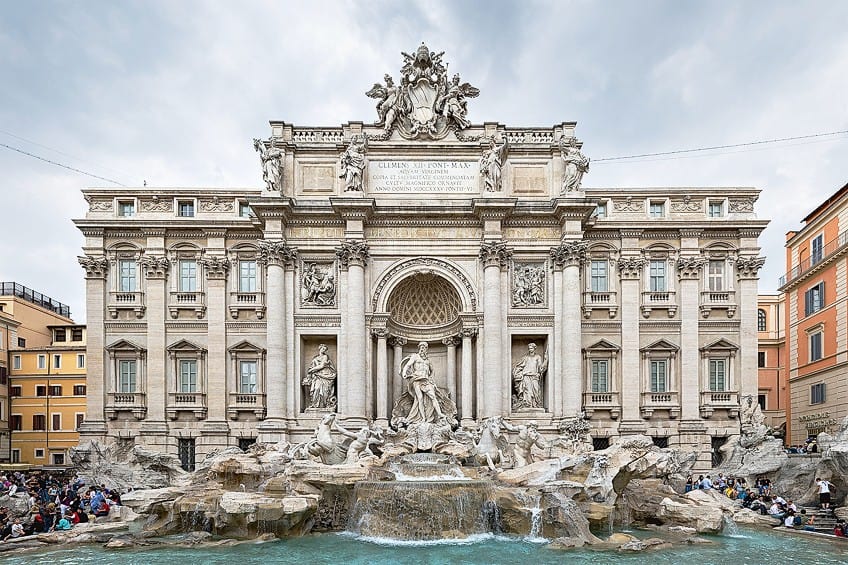Famous Fountains in Rome – Rome’s Most Mesmerizing Fountains
Rome is famous for many things, and one of those things is the many famous fountains in Italy. While there were ancient Roman fountains, many of these did not survive into the modern day, and so many of the most famous fountains in Rome were instead constructed later. These incredibly famous fountains in Italy are all, despite not being ancient Roman, still rather ancient. We are going to look at ten of the most famous fountains in Rome in this article. We will discuss who created them, where they are located, and what makes them so famous. Keep reading to learn more about some of the most famous fountains in Rome!
Ten of the Most Famous Fountains in Rome
Rome’s fountains are often considered some of the most gorgeous pieces of public art in this already famous city. Some of the most famous fountains in the world are also some of the most famous fountains in Rome. The purpose of a fountain has undergone change over the last few centuries, as they once served a very specific function as locations where water could be gathered by citizens, but in more recent years, they have become pieces of art in their own right. The technical need for fountains, in the traditional sense, has diminished thanks to the existence of public taps, but Rome’s fountains have remained all the same.
So, let’s have a look at ten of the most famous fountains in Rome to see why they’re so famous, and why they should be appreciated as stunning works of art.
Fountain in Piazza Santa Maria (Possibly 8th Century) in Trastevere
| Creator | Donato Bramante (1444 – 1514) |
| Date | Possibly 8th century |
| Materials Used | Marble and stone |
| Location | Trastevere, Rome |
The Fountain in Piazza Santa Maria in Trastevere is a particularly ancient Roman fountain. This particular fountain is often considered to be the oldest in Rome with its origins going back as far as the 8th century. However, that original form does not exist in the fountain’s present state. Instead, the current fountain is the work of the Renaissance architect and sculptor Donato Bramante.

There have been other additions made to it over the years. The structure of this fountain is polygonal. The basin is comprised of a large central section out of which the central spout is located. This fountain also includes a number of different coats of arms, indicating the legacies of several different popes, and there is also an emblem on the structure that references the Lopez family. This is one of the most famous fountains in Italy.
Fontana della Navicella (1518 – 1519) in Caelian Hill
| Creator | Andrea Sansovino (1467 – 1529) |
| Date | 1518 – 1519 |
| Materials Used | Marble and travertine |
| Location | Caelian Hill, Rome |
The Fontana della Navicella is a rather peculiar fountain because the central feature around which it is constructed is a ship. The fountain itself is actually a replica cast in marble and travertine. The fountain’s central sculpture is based on an Ancient Roman sculpture. This copy was only produced in the 16th century, but the original would have been from the Ancient Roman period.
The central sculpture, which depicts a Roman galley, is situated in front of a church.

This church is the Santa Maria in Domnica. The fountain itself is relatively recent as the sculpture was attached to it in the 1930s. The sculpture itself is ancient though. An interesting, if problematic, detail about the recent existence of this fountain is that it is often the victim of vandalism.
Fontana del Moro (1570s) in Piazza Navona
| Creator | Giacomo della Porta (1532 – 1602) and Gian Lorenzo Bernini (1598 – 1680) |
| Date | 1570s |
| Materials Used | Marble |
| Location | Piazza Navona, Rome |
The Fontana del Moro is a large fountain that depicts a number of separate sculptures that all form a composite part of the fountain as a whole. The structure is made up of two separate levels with a higher basin that includes this sculptural group while the lower basin simply contains water. The site has become a popular tourist destination because of the sheer beauty of the structure in its entirety.
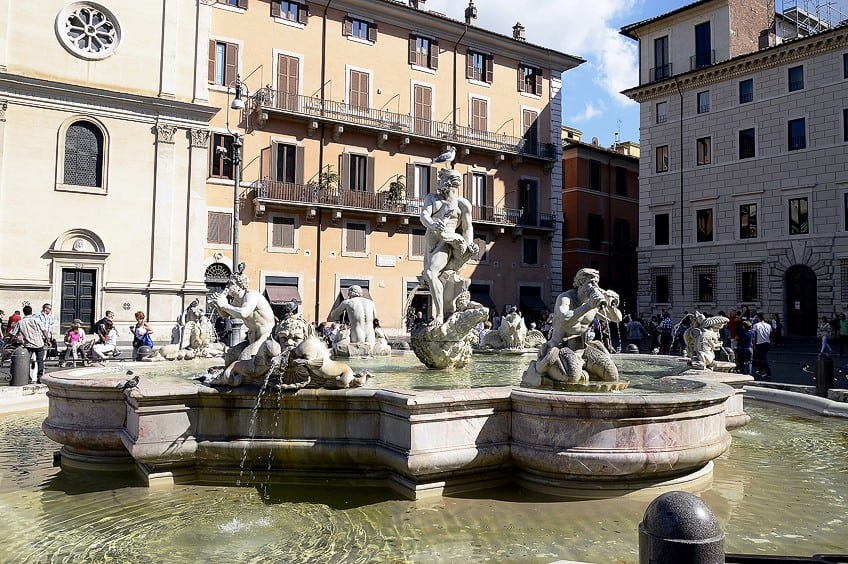
The sculptural scene that is depicted is one that makes use of a variety of figures. These figures are arranged in a nautical scene, and there are various ocean-themed images, such as conches and dolphins. The central sculpted figure is actually depicted wrestling with a dolphin.
This fountain is considered to be one of the most famous fountains in Rome and has remained a stunning example of Renaissance sculpture into the present day.
Fontana del Pantheon (1575) in Piazza della Rotonda
| Creator | Giacomo della Porta (1532 – 1602) and Leonardo Sormani (1550 – 1592) |
| Date | 1575 |
| Materials Used | Marble |
| Location | Piazza della Rotonda, Rome |
The Fontana del Pantheon is a highly ornate and detailed sculptured fountain that is situated in the center of the Piazza della Rotonda. As the name of the fountain may suggest, this stunning structure is located directly in front of the Pantheon itself. This means that this fountain would be one of the most visited in the city simply thanks to its proximity to the most famous Ancient Roman temple and now a church.

This fountain, which thanks to its location is one of the most famous fountains in Rome, is constructed out of marble and was sculpted in the Renaissance period. However, there is an addition that was fixed to the structure in the early 18th century. An ancient obelisk of Ancient Egyptian origin was added to the fountain. This, along with its location, has made this fountain one of the most famous and stunning examples of Renaissance Roman art and sculpture.
Fontana delle Tartarughe (1580 – 1588) in Sant’Angelo
| Creator | Giacomo della Porta (1532 – 1602) and Taddeo Landini (1561 – 1596) |
| Date | 1580 – 1588 |
| Materials Used | Marble and bronze |
| Location | Sant’Angelo, Rome |
The Fontana delle Tartarughe is a gorgeous fountain in Rome that was, like many of the most famous fountains in Rome, created during the Italian Renaissance. This particular Roman fountain is also famous because it makes use of a marble base and general construction alongside bronze sculptures. The bronze figures, which depict found young boys, are seen holding a number of turtles aloft.
The original design did not actually entail the use of any turtles, and there were instead a number of dolphins.

However, there were issues with water pressure in the mid-17th century because of this, hence the change in spouts. Regardless of the water pressure issues, this has become Rome’s most famous fountain, and also a stunning example of Renaissance sculpture. The changes that were made to the construction are also a fascinating piece of history that helps to show that pieces of art such as this are also meant to be functional as well as aesthetically pleasing.
Fontana della Barcaccia (1627 – 1629) in Piazza di Spagna
| Creator | Pietro Bernini (1562 – 1629) and Gian Lorenzo Bernini (1598 – 1680) |
| Date | 1627 – 1629 |
| Materials Used | Travertine |
| Location | Piazza di Spagna, Rome |
The Fontana della Barcaccia is another of the fountains in Rome that is shaped like a boat. In this particular case, this fountain was commissioned in the 17th century by the Pope and was designed by Pietro Bernini, and his son, Gian Lorenzo Bernini, who would go on to considerably more fame than his father. Together, they designed this fountain to look like a sinking ship that is overflowing.

The reason for the fountain’s existence was because it was meant to commemorate the Acqua Vergine aqueduct’s recent restoration efforts. This aqueduct supplied many of the fountains throughout Rome with the water they needed. The fountain itself was made out of travertine and it included a more rectangular main basin with a central oval basin.
Additionally, the central pedestal includes two coats of arms that represent the family of the Pope.
Fontana del Tritone (1642 – 1643) in Piazza Barberini
| Creator | Gian Lorenzo Bernini (1598 – 1680) |
| Date | 1642 – 1643 |
| Materials Used | Travertine |
| Location | Piazza Barberini, Rome |
The Fontana del Tritone is a travertine statue that depicts the Ancient Greek god Triton. Triton was a god of the sea and the son of Poseidon, and it was one of the many famous fountains in Rome that were designed by Gian Lorenzo Bernini. It is considered to be one of the best examples of Baroque art in the city and a stunning example of drawing influences from Ancient Roman fountains too.

The fountain shows Triton blowing on a conch shell as he is lifted by four dolphins that twist around the base of the fountain and hold him aloft. There is also the coat of arms of the Pope on the fountain seeing as he commissioned it. This was another of the fountains that were constructed thanks to the Acqua Vergine’s restoration.
Fontana delle Api (1644) in Piazza Barberini
| Creator | Gian Lorenzo Bernini (1598 – 1680) |
| Date | 1644 |
| Materials Used | Marble and travertine |
| Location | Piazza Barberini, Rome |
The Fontana delle Api is one of the cuter fountains in Rome. This particular fountain was yet another that was designed by Gian Lorenzo Bernini, commissioned by Pope Urban VIII, and built to commemorate the restoration of the Acqua Vergine aqueduct. In this case, the fountain had a slightly different proposed function from some of the others.
This fountain was meant to be an artificial watering hole used by horses.
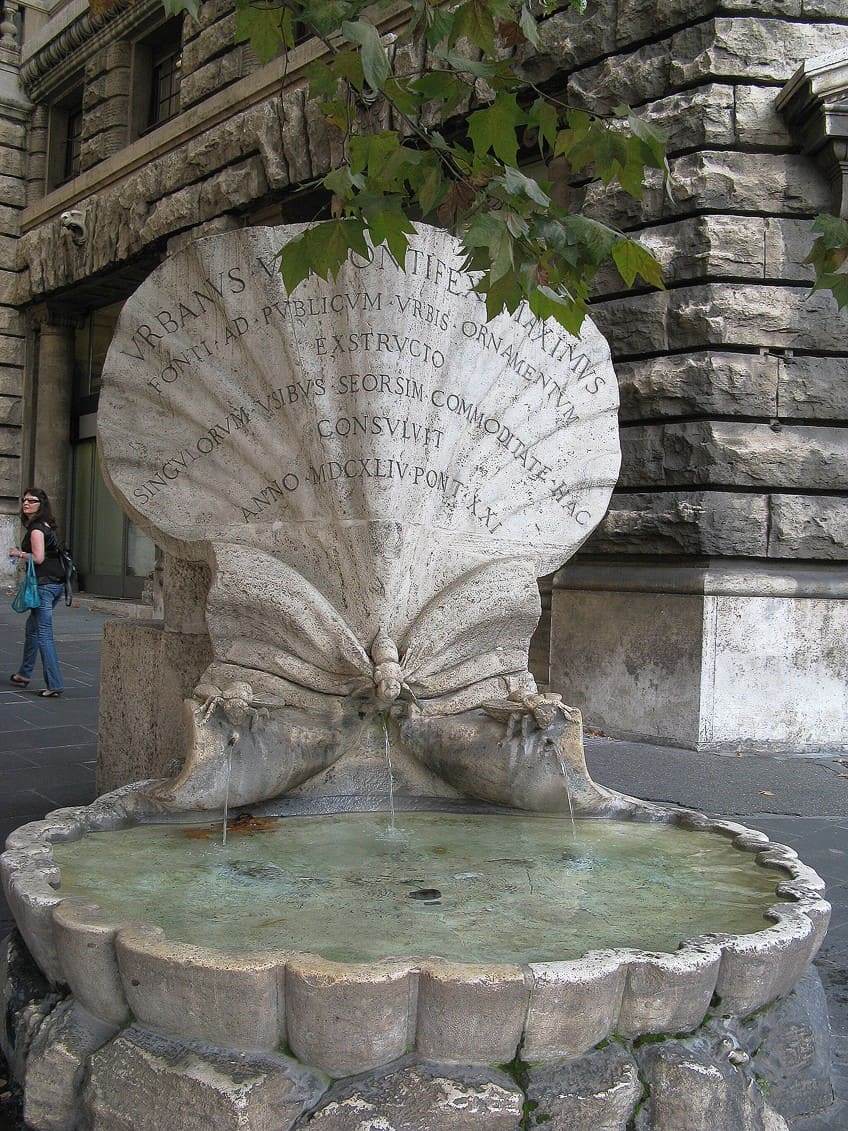
The fountain itself makes use of a shell design made of marble while the remainder of the fountain is made of travertine. The fountain did not always reside at its present location. Originally, it was located in the Palazzo Soderini, but it was moved in 1916 to its present location and has become a popular tourist spot ever since.
Fontana dei Quattro Fiumi (1651) in Piazza Navona
| Creator | Gian Lorenzo Bernini (1598 – 1680) |
| Date | 1651 |
| Materials Used | Travertine |
| Location | Piazza Navona, Rome |
The Fontana dei Quattro Fiumi is yet another of the fountains meant to be a celebratory piece for the restoration of the Acqua Vergine aqueduct. This was, however, commissioned by a different Pope, Innocent X. It was still designed by the same famed sculptor, Gian Lorenzo Bernini. This is another of the Baroque fountains that he designed, and it is considered to be one of his masterpieces.
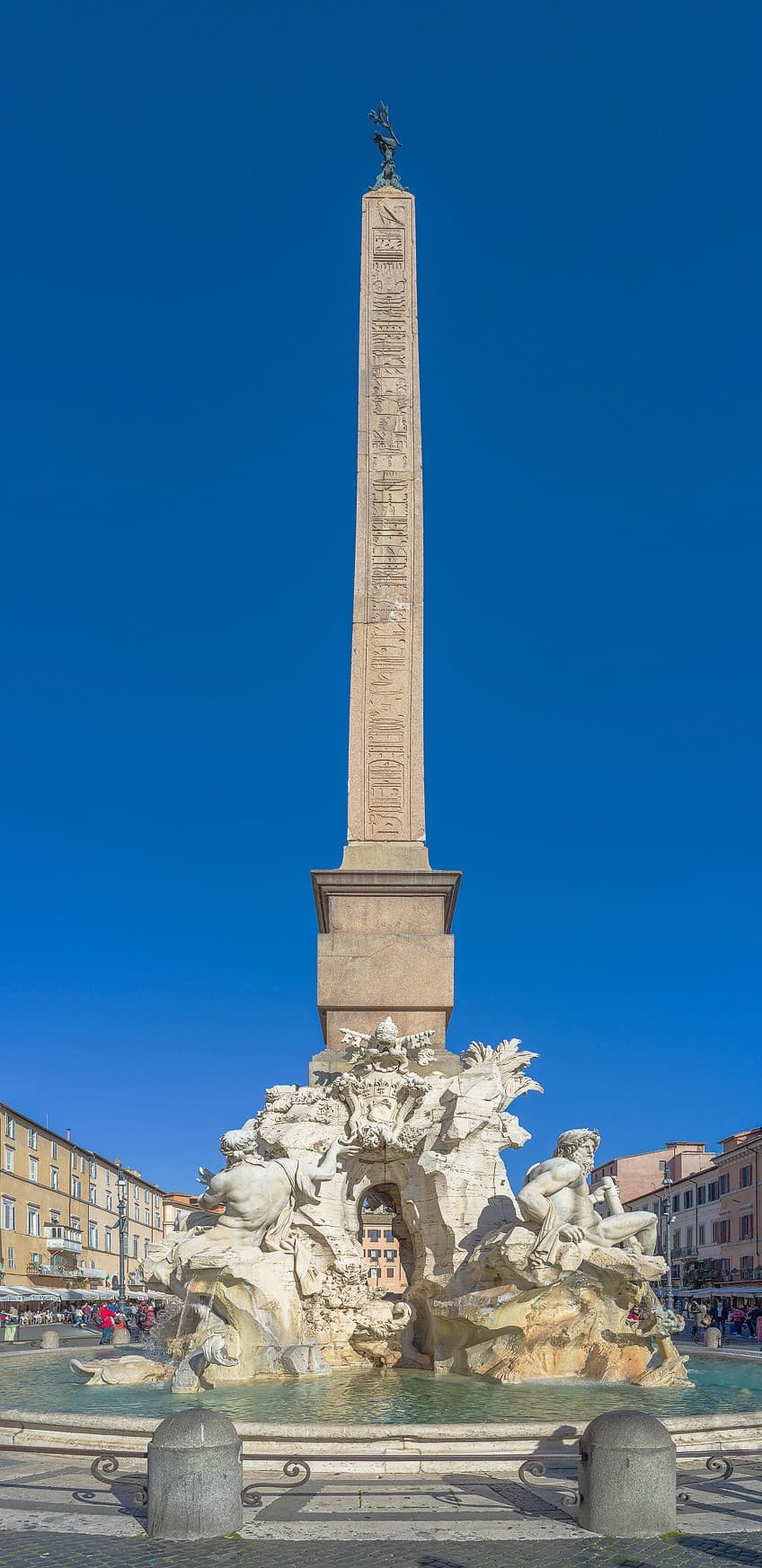
The fountain itself depicts four river gods surrounding a central obelisk. The obelisk is actually a later addition as it is an Ancient Egyptian obelisk that was taken from elsewhere and added to the fountain. The obelisk does have a small addition in the form of a dove with an olive branch at the very top.
This is meant to be emblematic of the Pope’s family.
Trevi Fountain (1762) in Trevi
| Creator | Nicola Salvi (1697-1751) |
| Date | 1762 |
| Materials Used | Travertine |
| Location | Trevi, Rome |
The Trevi Fountain is likely the most famous fountain in Rome. Of all Rome’s fountains, the Trevi Fountain is also arguably the oldest. The current fountain was designed by Nicola Salvi (although he left it incomplete and it needed to be completed by Giuseppe Pannini), but this 18th-century fountain sits atop the location out of which the Aqua Virgo aqueduct ended.
This means that while the present fountain may be an 18th-century work, the original location may have been home to the first ever fountain in Rome. This is, however, not certain, and is rather something that has been proposed.
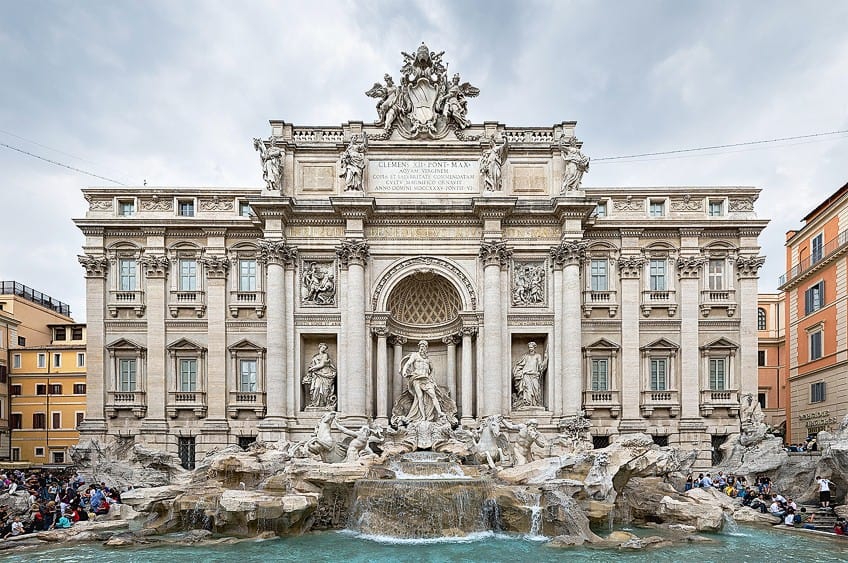
It is an interesting proposal though, and it does question the idea of what the oldest fountain in this ancient city is. The present fountain depicts a scene from Roman mythology. This particular scene involves the god of the sea, Oceanus, riding a chariot pulled by sea horses. There are also other figures that surround him, and so this fountain can be seen as a sculptural group. These sculptures, and the fountain as a whole, were made of a variety of materials, like travertine, marble, and bronze.
And that was our discussion about the most famous fountains in Rome. These famous fountains have served as immensely functional locations over the centuries, but while that functionality has reduced in recent decades, their artistic beauty has never diminished. Over the course of this article, we examined ten of Rome’s fountains to find out which are the most famous, the most gorgeous, and the most historically significant. Hopefully, you have learned a good deal about these famous fountains in Italy today, but there is always more that you could learn about.
Frequently Asked Questions
What Is the Most Famous Fountain in Rome?
The most famous fountain in Rome is always up for debate, but it’s likely that the Trevi Fountain is the most famous. This Late Baroque fountain is considered one of the most stunning Roman fountains ever constructed, and it has also remained a popular tourist destination for decades. This fountain is also famous for a bit of a legend that is attached to it, because the Trevi Fountain is also one into which people throw coins, and, supposedly, those who throw coins into the water will one day return to Rome.
What Is the Oldest Fountain in Rome?
This is actually a more difficult question than it may first appear. The Santa Maria in Trastevere is the oldest standing fountain in Rome, but it could be argued that even though it dates back to the 8th century CE, it isn’t necessarily the oldest in another sense. Ancient Roman fountains were designed at the end of aqueducts, and so it can also be argued that the Trevi Fountain, which was the end point of Aqua Virgo, one of the first aqueducts, is actually the oldest in a technical sense. However, the physical fountain design that is today called the Trevi Fountain is definitely not the oldest.
What Are Fountains in Rome Usually Made From?
Rome’s fountains are often made from a variety of materials. Many of the fountains in Rome are made of either marble or stone, and a few others are made of bronze. However, as materials like marble are especially good mediums for sculpture, and seeing as many of the most famous fountains in Italy are also sculpted masterpieces, it makes sense that marble would be used in many of the most famous of Rome’s fountains.
Who Is the Most Famous Fountain Designer from Rome?
The most famous fountain designer was probably Gian Lorenzo Bernini. This man was both a sculptor and architect, and he designed some of the most famous fountains in Rome. He is credited as the sculptor in many of the fountains in the list above. He designed fountains such as the Fountain of the Four Rivers in Piazza Navona and the Fountain of the Triton in Piazza Barberini. He even had a hand in the Trevi Fountain, which is often considered to be the most famous fountain in Rome.
What Was the Purpose of Fountains in Ancient Rome?
Ancient Roman fountains had a far more functional purpose than many contemporary fountains. Today, fountains are gorgeous pieces of sculpted art that also serve as water displays. However, in Ancient Rome, fountains were directly connected to aqueducts. This allowed water to be supplied to Rome’s residents and could be used for drinking water, public baths, and whatever other purposes for which water was needed. Fountains served an integral role in the development of Rome, as they allowed for the distribution of water.
Justin van Huyssteen is a writer, academic, and educator from Cape Town, South Africa. He holds a master’s degree in Theory of Literature. His primary focus in this field is the analysis of artistic objects through a number of theoretical lenses. His predominant theoretical areas of interest include narratology and critical theory in general, with a particular focus on animal studies. Other than academia, he is a novelist, game reviewer, and freelance writer. Justin’s preferred architectural movements include the more modern and postmodern types of architecture, such as Bauhaus, Art Nouveau, Art Deco, Brutalist, and Futurist varieties like sustainable architecture. Justin is working for artfilemagazine as an author and content writer since 2022. He is responsible for all blog posts about architecture.
Learn more about Justin van Huyssteen and about us.
Cite this Article
Justin, van Huyssteen, “Famous Fountains in Rome – Rome’s Most Mesmerizing Fountains.” artfilemagazine – Your Online Art Source. July 6, 2023. URL: https://artfilemagazine.com/famous-fountains-in-rome/
van Huyssteen, J. (2023, 6 July). Famous Fountains in Rome – Rome’s Most Mesmerizing Fountains. artfilemagazine – Your Online Art Source. https://artfilemagazine.com/famous-fountains-in-rome/
van Huyssteen, Justin. “Famous Fountains in Rome – Rome’s Most Mesmerizing Fountains.” artfilemagazine – Your Online Art Source, July 6, 2023. https://artfilemagazine.com/famous-fountains-in-rome/.


